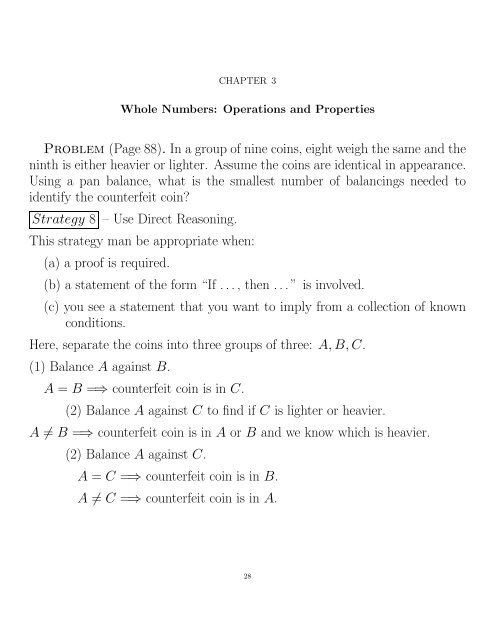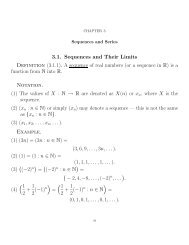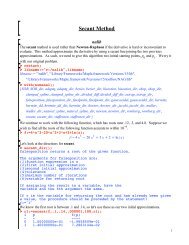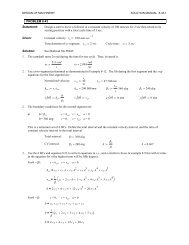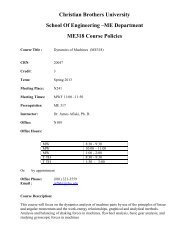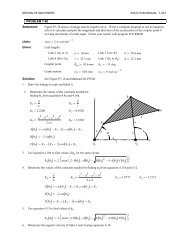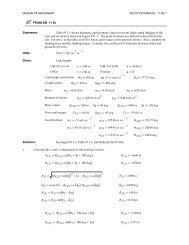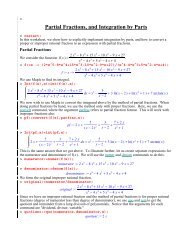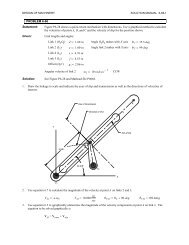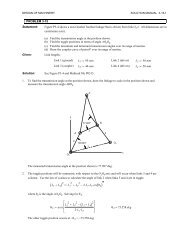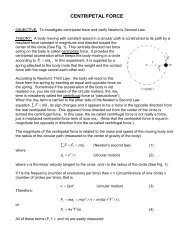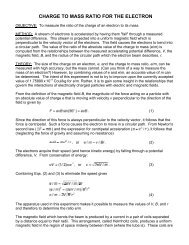Problem (Page 88). In a group of nine coins, eight weigh the same ...
Problem (Page 88). In a group of nine coins, eight weigh the same ...
Problem (Page 88). In a group of nine coins, eight weigh the same ...
You also want an ePaper? Increase the reach of your titles
YUMPU automatically turns print PDFs into web optimized ePapers that Google loves.
CHAPTER 3Whole Numbers: Operations and Properties<strong>Problem</strong> (<strong>Page</strong> <strong>88</strong>). <strong>In</strong> a <strong>group</strong> <strong>of</strong> <strong>nine</strong> <strong>coins</strong>, <strong>eight</strong> <strong>weigh</strong> <strong>the</strong> <strong>same</strong> and <strong>the</strong>ninth is ei<strong>the</strong>r heavier or lighter. Assume <strong>the</strong> <strong>coins</strong> are identical in appearance.Using a pan balance, what is <strong>the</strong> smallest number <strong>of</strong> balancings needed toidentify <strong>the</strong> counterfeit coin?Strategy 8 – Use Direct Reasoning.This strategy man be appropriate when:(a) a pro<strong>of</strong> is required.(b) a statement <strong>of</strong> <strong>the</strong> form “If . . . , <strong>the</strong>n . . . ” is involved.(c) you see a statement that you want to imply from a collection <strong>of</strong> knownconditions.Here, separate <strong>the</strong> <strong>coins</strong> into three <strong>group</strong>s <strong>of</strong> three: A, B, C.(1) Balance A against B.A = B =) counterfeit coin is in C.(2) Balance A against C to find if C is lighter or heavier.A 6= B =) counterfeit coin is in A or B and we know which is heavier.(2) Balance A against C.A = C =) counterfeit coin is in B.A 6= C =) counterfeit coin is in A.28
3.1. ADDITION AND SUBTRACTION 29Name <strong>the</strong> three <strong>coins</strong> in <strong>the</strong> chosen <strong>group</strong> a, b, c.(3) Balance a against b.a = b =) counterfeit coin is c.a 6= b and chosen <strong>group</strong> heavier =) counterfeit coin is heavier <strong>of</strong> a and b.a 6= b and chosen <strong>group</strong> lighter =) counterfeit coin is lighter <strong>of</strong> a and b.Two models <strong>of</strong> addition:3.1. Addition and Subtraction(1) The set model – uses <strong>the</strong> union <strong>of</strong> disjoint sets.Definition (Addition <strong>of</strong> Whole Numbers). Let A and B be any two wholenumbers. If A and B are disjoint sets with a = n(A) and b = n(B), <strong>the</strong>na + b = n(A [ B).“a” and “b” are called addends or summands.Addition is called a binary operation since two numbers are combined to producea unique number.
30 3. WHOLE NUMBERS: OPERATIONS AND PROPERTIES(2) The measurement model – uses directed arrows on a number line.Properties <strong>of</strong> whole number addition:Closure propertyThe sum <strong>of</strong> any two whole numbers is a whole number.Example. The even whole numbers are closed under addition.The odd whole numbers are not closed under addition. Why?Commutative propertyLet a and b be any whole numbers. Then a + b = b + a.Associative propertyLet a, b, and c be any whole numbers. Then(a + b) + c = a + (b + c).
3.1. ADDITION AND SUBTRACTION 31Identity propertyThere is a unique whole number, namely 0, such that for all whole numbers a,a + 0 = a = 0 + a.The number 0 is called <strong>the</strong> additive identity or <strong>the</strong> identity for addition.Thinking strategies for learning <strong>the</strong> addition facts:There are 100 places to be filled in <strong>the</strong> following table. We illustrate 4 + 1 = 5.
32 3. WHOLE NUMBERS: OPERATIONS AND PROPERTIES(1) Commutativity – once <strong>the</strong> lower left <strong>of</strong> <strong>the</strong> table is completer, <strong>the</strong> upperright is obtained by commutativity.(2) Adding zero –using a + 0 = a fills <strong>the</strong> leftmost column.(3) Counting on by 1 and 2 – e.g., for 7 + 1, 7 + 2, think 7, 8, 9. This gives <strong>the</strong>next two columns.
3.1. ADDITION AND SUBTRACTION 33(4) Combinations to 10 – using fingers, 7 + 3, 6 + 4, 5 + 5, etc. all equal 10.(5) Adding doubles –down <strong>the</strong> main diagonal, 1 + 1 = 2, 2 + 2 = 4, 3 + 3 = 6,etc., or counting by two’s: 2, 4, 6, 8, . . .The pattern for <strong>the</strong> remaining numbers is clear, or just use (6) - (8) below.(6) Adding 10 – 4 + 10 = 14, 8 + 10 = 18, etc. Pretty clear(7) Associativity –9 + 7 = 10 + 6 = 16 since 9 + 7 = 9 + (1 + 6) = (9 + 1) + 6 = 10 + 68 + 5 = 10 + 3 = 13 since 8 + 5 = 8 + (2 + 3) = (8 + 2) + 3 = 10 + 3(8) Doubles ±1 and ±2 –8 + 9 = 8 + 8 + 1 = 16 + 1 = 178 + 7 = 8 + 8 1 = 16 1 = 15
34 3. WHOLE NUMBERS: OPERATIONS AND PROPERTIES7 + 9 = 7 + 7 + 2 = 14 + 2 = 168 + 6 = 8 + 8 2 = 16 2 = 14<strong>Problem</strong> (<strong>Page</strong> 101 # 8).Subtraction – two approaches:(1) The take-away approach –The set model:(2) The measurement model:
3.1. ADDITION AND SUBTRACTION 35Definition (Subtraction – Take-Away Approach).Let a and b be any whole numbers and A and B be sets such that a = n(A),b = n(B), and B ✓ A. Thena b = n(A B).“a b” is <strong>the</strong> di↵erence <strong>of</strong> a and b, “a” is <strong>the</strong> minuend, and “b” is <strong>the</strong> subtrahend.Subtraction – <strong>the</strong> missing addend approachDefinition (Subtraction - Missing Addend Approach).Let a and b be any whole numbers. Then a b = c if and only if ( () )a = b + c for some whole number c.This approach is useful for learning subtraction facts by relating <strong>the</strong>m to additionfacts via four-fact families:
36 3. WHOLE NUMBERS: OPERATIONS AND PROPERTIESMany subtraction facts can be obtained from an addition facts table.Example (A Two Set, Comparison Model, Using Matching). If Larry has$7 and Judy has $3, how much more money does Larry have?7 3 = 4After matching, we can use ei<strong>the</strong>r <strong>the</strong> take-away or <strong>the</strong> missing addend approach.Note. Subtraction is not closed, for 3 5 does not have a whole number asan answer. What about <strong>the</strong> o<strong>the</strong>r properties we have for addition?Example (Four fact family in base 5).3 5 + 4 5 =12 54 5 + 3 5 =12 512 5 3 5 =4 512 5 4 5 =3 5
Approaches to Multiplication(1) Repeated addition approach3.2. MULTIPLICATION AND DIVISION 373.2. Multiplication and Division3 + 3 + 3 + 3 + 3 = 15 or 5 ⇥ 3 = 15Definition (Multiplication – Repeated Addition Approach).Let a and b be any whole numbers where a 6= 0. Thenab = b | + b + {z· · · + } b .a addendsIf a = 1, <strong>the</strong>n ab = 1 · b = b; also 0 · b = 0 for all b.a and b are called factors, and ab is called <strong>the</strong> product.
38 3. WHOLE NUMBERS: OPERATIONS AND PROPERTIES(2) Rectangular array approach3 + 3 + 3 + 3 + 3 = 15 or 5 ⇥ 3 = 15Definition (Multipication - Rectangular Array Approach).Let a and b be any whole numbers. Then ab is <strong>the</strong> number <strong>of</strong> elements in arectangular array having a rows and b columns.(3) Cartesian Product Approach2 ⇥ 3 = 6Definition (Multipication - Cartesian Product Approach).Let a and b be any whole numbers. If a = n(A) and b = n(B) for some sets Aand B,ab = n(A ⇥ B).
3.2. MULTIPLICATION AND DIVISION 39An alternative version <strong>of</strong> (3) is:(4) Tree Diagram Approach2 ⇥ 3 = 6Properties <strong>of</strong> Whole Number Multiplication:(1) Closure PropertyThe product <strong>of</strong> two whole numbers is a whole number.Example. The set <strong>of</strong> odd whole numbers and <strong>the</strong> set <strong>of</strong> even whole numbersare both closed under multiplication, but <strong>the</strong> setis not closed since 3 · 8 /2 A.Commutative PropertyA = {3, 8, 13, 18, 23, 28, . . . }Let a and b be any whole numbers. Thenab = ba.
40 3. WHOLE NUMBERS: OPERATIONS AND PROPERTIES(3) Associative PropertyLet a, b, and c be any whole numbers. Thena(bc) = (ab)c.(4) Identity PropertyThe number 1 is <strong>the</strong> unique whole number such that for every whole numbera,a · 1 = a = 1 · a.1 is called <strong>the</strong> multiplicative identity or <strong>the</strong> identity for multiplication.(5) Distributive Property <strong>of</strong> Multiplication over AdditionLet a, b, and c be any whole numbers. Thena(b + c) = ab + ac.The 3 is distributed to <strong>the</strong> 2 and <strong>the</strong> 4.Note. This property relates <strong>the</strong> operations <strong>of</strong> addition and multiplication.
3.2. MULTIPLICATION AND DIVISION 41(6) Distributive Property <strong>of</strong> Multiplication over AdditionLet a, b, and c be any whole numbers. Then, provided b c,a(b c) = ab ac.Pro<strong>of</strong>.Let b c = n.Then b = c + n (Missing addend).ab = a(c + n).ab = ac + an (distributive)Thus ab ac = an (missing addend)But b c = n.So ab ac = a(b c). ⇤Multiplication Property <strong>of</strong> ZeroFor every whole number a,a · 0 = 0 · a = 0.
42 3. WHOLE NUMBERS: OPERATIONS AND PROPERTIESThinking Strategies for Learning Multiplication Facts:(1) Commutativity –just as with addition, once we find 55 facts, <strong>the</strong> o<strong>the</strong>rs areobtained by commutativity.(2) Multiplication by 0 – since a · 0 = 0, <strong>the</strong> first column is all 0’s.(3) Multiplication by 1 – since a · 1 = a, <strong>the</strong> second column is identical to <strong>the</strong>left-hand column.(4) Multiplication by 2 – since a · 2 = a + a, <strong>the</strong> third column is doubles fromaddition.(5) Multiplication by 5 – use counting chant by 5’s : 5, 10, 15, etc.(6) Multiplication by 9 – ten’s digit is one less than number we are multiplyingby 9, and <strong>the</strong> sum <strong>of</strong> <strong>the</strong> digits is 9.9 ⇥ 1 = 9, 9 ⇥ 2 = 18, 9 ⇥ 3 = 27, . . .
3.2. MULTIPLICATION AND DIVISION 43(7) Associativity and Distributivity –Example.8 ⇥ 6 = 8(3 + 3) = 8 · 3 + 8 · 3 = 24 + 24 = 487 ⇥ 4 = 7(2 ⇥ 2) = (7 ⇥ 2) ⇥ 2 = 14 ⇥ 2 = 28<strong>Problem</strong> (<strong>Page</strong> 118 # 11a).
44 3. WHOLE NUMBERS: OPERATIONS AND PROPERTIESDivision – two conceptual ways <strong>of</strong> viewing:Sharing (partative) division – breaking a <strong>group</strong> <strong>of</strong> objects into a specified number<strong>of</strong> <strong>group</strong>s (at <strong>the</strong> beginning, <strong>the</strong> number <strong>of</strong> <strong>group</strong>s is known, but <strong>the</strong> <strong>group</strong>size isn’t).Measurement division – breaking a <strong>group</strong> <strong>of</strong> objects into a number <strong>of</strong> <strong>group</strong>s<strong>of</strong> a specified size (at <strong>the</strong> beginning, <strong>the</strong> size <strong>of</strong> each <strong>group</strong> is known, but <strong>the</strong>number <strong>of</strong> <strong>group</strong>s isn’t)Missing factor approachDefinition.If a and b are any whole numbers with b 6= 0, <strong>the</strong>n a ÷ b = c if and only ifa = bc for some whole number c.a is called <strong>the</strong> dividend, b is called <strong>the</strong> divisor, and c is called <strong>the</strong> quotient.
3.2. MULTIPLICATION AND DIVISION 45This is based on ano<strong>the</strong>r four-fact family:Division Property <strong>of</strong> zeroIf a 6= 0, <strong>the</strong>n 0 ÷ a = 0.What about dividing by 0?(1) If a 6= 0 and a ÷ 0 = c, <strong>the</strong>n a = 0 · c = 0, a contradiction.(2) If 0 ÷ 0 = c, <strong>the</strong>n 0 = 0 · c for any whole number c, so <strong>the</strong>re is no uniquequotient. Thus division by 0 is undefined.Division with Remainder – having some objects left over.Theorem – a statement that can be proved based on o<strong>the</strong>r results.Theorem (Division Algorithm). If a and b are any whole numbers withb 6= 0, <strong>the</strong>n <strong>the</strong>ir exist unique whole numbers q and r such thata = bq + r where 0 apple r < b.a is <strong>the</strong> dividend, b <strong>the</strong> divisor, q <strong>the</strong> quotient, and r <strong>the</strong> remainder.
46 3. WHOLE NUMBERS: OPERATIONS AND PROPERTIESAlternative ways <strong>of</strong> viewing <strong>the</strong> repeated-subtraction approach.<strong>Problem</strong> (<strong>Page</strong> 118 # 11b).i) 61 8 ÷ 7 8 = 7 8ii) 17 8 ÷ 3 8 = 5 8iii) 30 8 ÷ 6 8 = 4 8iv) 16 8 ÷ 2 8 = 7 8v) 44 8 ÷ 6 8 = 6 8vi) 25 8 ÷ 7 8 = 3 83.3. Ordering and ExponentsOrdering and Whole Number OperationsDefinition (“Less Than” for Whole Numbers).For any two whole numbers a and b, a < b (or b > a) if and only if <strong>the</strong>re is anonzero whole number n such that a + n = b.apple means less than or equal to.means greater than or equal to.
3.3. ORDERING AND EXPONENTS 47Transitive Property <strong>of</strong> Less Than for Whole NumbersFor all whole numbers a, b, and c, if a < b and b < c, <strong>the</strong>n a < c.Pro<strong>of</strong>.a < b =) a + n = b for some whole nonzero whole number n.b < c =) b + m = c for some whole nonzero whole number m.Then (a + n) + m = b + m =) a + (n + m) = b + m =) a + (n + m) = c,and n + m is a nonzero whole number, so a < c.⇤Note. The transitive property also holds if >,, or apple are used throughout.Less Than and Addition for Whole NumbersIf a < b, <strong>the</strong>n a + c < b + c.Less Than and Multiplication for Whole NumbersIf a < b and c 6= 0, <strong>the</strong>n ac < bc.
48 3. WHOLE NUMBERS: OPERATIONS AND PROPERTIESExponents – used to simplify multiplication expressions.Definition (Whole Number Exponent).Let a and m be any whole numbers where m 6= 0. Thena m = a · a · · · a | {z }m factorsm is <strong>the</strong> exponent or power <strong>of</strong> a, and a is called <strong>the</strong> base.Example.Theorem.3 5 · 3 3 = (3 · 3 · 3 · 3 · 3) · (3 · 3 · 3) = 3 8Let a, m, and n be any whole numbers where m and n are nonzero. ThenPro<strong>of</strong>.a m · a n = a · a · · · a | {z }m factorsa m · a n = a m+n .· a · a · · · a | {z }n factors= a · a · · · a | {z }m + n factors= a m+n ⇤Example.3 3 · 5 3 = (3 · 3 · 3) = (5 · 5 · 5) = (3 · 5) · (3 · 5) · (3 · 5) = (3 · 5) 3Theorem.Let a, b, and m be any whole numbers where m 6= 0. ThenPro<strong>of</strong>.a m · b m = a · a · · · a | {z }m factorsa m · b m = (ab) m .· b · b · · · b | {z }m factors= (ab) · (ab) · · · (ab)| {z }m factors= (ab) m ⇤
Example.Theorem.3.3. ORDERING AND EXPONENTS 49(4 2 ) 3 = 4 2 · 4 2 · 4 2 = 4 6Let a, m, and n be any whole numbers where m and n are nonzero. ThenThusExample.Theorem.(a m ) n = a mn .6 8 ÷ 6 3 = 6 5 since 6 3 · 6 5 = 6 8 .6 8 ÷ 6 3 = 6 8 3 .Let a, m, and n be any whole numbers where m > n and a, m, and n arenonzero. Thena m ÷ a n = a m n .0 as an exponentFor a 6= 0, consider <strong>the</strong> pattern:a 3 = a · a · aDivide each side by a.a 2 = a · aDivide each side by a.a 1 = aDivide each side by a.a 0 = 1Definition. a 0 = 1 for all whole numbers a 6= 0.
50 3. WHOLE NUMBERS: OPERATIONS AND PROPERTIESConsider <strong>the</strong> two following patterns:Pattern 1: 3 0 = 1, 2 0 = 1, 1 0 = 1, 0 0 = ?Pattern 2: 0 3 = 0, 0 2 = 0, 0 1 = 0, 0 0 = ?Each pattern suggests a di↵erent answer to 0 0 , so:Note. 0 0 is not defined.Order <strong>of</strong> Operations – an agreementExample.11 2 2 ÷ 2 · 5 + (7 (6 2)) =(1) Paren<strong>the</strong>ses (from inside out)11 2 2 ÷ 2 · 5 + (7 4) =11 2 2 ÷ 2 · 5 + 3 =(2) Exponents in order from left to right11 4 ÷ 2 · 5 + 3 =(3) Multiplications and divisions in order from left to right11 2 · 5 + 3 =11 10 + 3 =(4) Additions and subtractions in order fro left to rightNote.1 + 3 =(1) “Please Excuse My Dear Aunt Sally” is a useful pneunomic.(2) Most calculators (including those used at CBU) follow <strong>the</strong>se rules.4


